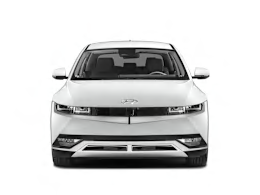The Ioniq 5 is one of the most impressive electric vehicles we’ve tested, with punchy acceleration, agile sports-sedan-like handling, a reasonably comfortable ride, and generous interior room. Plus, this tall hatchback employs an 800-volt architecture that allows for rapid DC fast-charging in public venues, which can reduce charging times on long trips.
With 320 horsepower on tap from front and rear electric motors (which give it all-wheel drive), the Ioniq 5 is quick, zipping from 0 to 60 mph in a scant 4.7 seconds. Not only does that time equal the Tesla Model Y, but it’s speedier than both the Ford Mustang Mach-E and Volkswagen ID.4. The Ioniq 5 delivers instant thrust off the line (without being neck-wrenching like the Model Y), followed by a linear flow of effortless power.
We like that Hyundai has made it easy for drivers to adjust the level of regenerative braking—which slows the car when it’s coasting—on the fly simply by tapping the paddles located behind the steering wheel. The feature recoups energy back to the battery that would otherwise be lost during braking. When you do press on the actual brake pedal, it feels almost normal, without the overly-soft, spongy sensation that plagues many EVs and some hybrids.
The EPA-rated driving range is 266 miles for all-wheel-drive models, and 303 miles for the single-motor, rear-wheel-drive versions with the 77.4-kilowatt-hour battery. We saw 267 miles in our own 70-mph highway range test with our all-wheel drive version. As with other EVs that have large batteries to deliver a robust driving range, it takes a full overnight of charging to replenish the battery at home using a typical 240-volt connector. But the Ioniq 5 can benefit from rapid charging at public DC fast-charging venues, thanks to its 400- and 800-volt architecture that allows a maximum of 250-kilowatt charging output—that’s an edge over many EV competitors.
Handling agility is a high point thanks to the car’s quick and responsive steering, taut suspension, and rear-wheel-drive-based chassis, all of which make it fun to drive on curvy roads. We like that switching the car to Sport mode firms up the steering (it feels a bit light and vague in Normal mode, especially at lower speeds) and alters the AWD distribution to send more power to the rear wheels. The suspension is firm but provides a comfortable ride that’s taut and controlled. It doesn’t soak up bumps as well as the ID.4, but it’s more absorbent than the Mustang Mach-E and miles better than the stiff and jittery Model Y.
The Ioniq 5’s interior has a clean, minimalist design, and it uses eco-friendly materials on the seats, door trim, and headliner. The flat floor and super-low center console make for a roomy cabin. Most of our testers found that the front seats offered a nice mixture of plushness and support, though some felt the seatback was too narrow. The rear seat has easy access, with loads of legroom and a generous amount of recline, but headroom can get tight for taller occupants.
Despite the car’s futuristic vibe, the controls are mostly easy to use and include some very helpful EV-specific displays. We also like that the icons on the center touch screen can be rearranged to make often-used functions more accessible. Some climate-control tasks are multiple-step operations, though, and the twist-lever electronic gear selector will take some familiarity before it becomes muscle-memory. We also found it strange, and a bit annoying, that Hyundai failed to include a wiper on the rear window—a feature that is nearly a given for hatchback models.
Forward collision warning, automatic emergency braking with pedestrian and cyclist detection, blind spot warning, rear cross traffic warning, lane centering assistance, lane departure warning, lane keeping assistance, and adaptive cruise control all come standard.


























